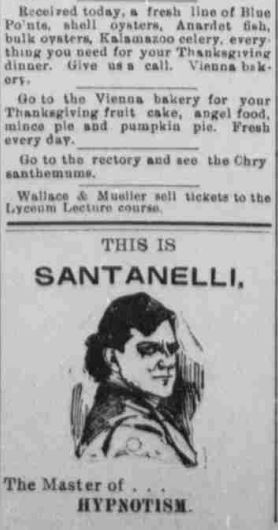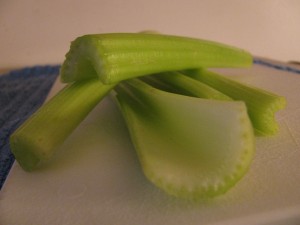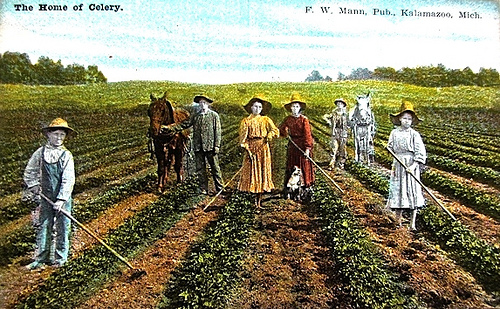Now that’s a blog post title I never imagined writing! I’d been researching this last installment of the “Old-Fashioned Thanksgiving” series (the subject today is 19th century Thanksgiving food) for y’all when I ran across this:

Once I got past the “Master of Hypnotism” ad…ooh, those spooky eyes…the term “Kalamazoo celery” just jumped right out at me. (If it’s not jumping out at you, it’s on the third line from the top).
Wow, I had no idea I needed Kalamazoo celery for my Thanksgiving feast. What have I been missing all these years?

To me, celery has always seemed the red-headed stepchild of vegetables. It’s the diet food that’s supposed to have negative calories, meaning you expend more calories chewing it than it contains. You’re obliged to buy it in this huge clump of stalks when you only need two or three stems, and you never use it all before it gets rubbery. Even when we had a guinea pig we couldn’t use it all up.
But perhaps, at Thanksgiving, celery finally gets its 15 minutes of fame. We’re stuffing it with cream cheese for hors d’oeuvres, mixing it into dressings, and simmering it in soups.
But Kalamazoo celery? What’s so special about that?
You know I couldn’t resist looking it up, right?
Ironically, what I found took me right back to the 19th century.
According to multiple sources, the origin of Kalamazoo’s celery-growing fame was Dutch immigrant Cornelius DeBruyn, who in 1866 cultivated celery in his backyard and developed a new variety with pale stalks that he called “Ivory Pascal.” Many folks preferred the flavor to the green variety grown in California at the time. It took off in popularity.
Over the next 50 years, more Dutch immigrants came to the Michigan area. These were people who were already accustomed to farming marshy land back home. Kalamazoo Michigan had plenty of the loamy, mucky soil and cool temperatures that made for good celery-growing conditions. Although it wasn’t ideal: the land was still a little too wet, so farmers had to dig trenches to drain the excess. But they were able to make it work.
There were other difficulties in growing celery. It was a labor-intensive process that had the entire family in the fields from sunrise to sunset. It would wilt in hot weather, and was susceptible to various insects and diseases. And even with special equipment, the plough-pulling horses would sink up their chests in the mud.

Some cool facts about Kalamazoo celery in the 19th century:
- The white and yellow varieties of Kalamazoo celery were milder and sweeter than the standard bitter green variety, and more popular.
- “bleaching boards” were used on each side of the stalks during the growing period, which blocked out the sun and produced the mild flavor.
- There were two harvesting seasons, July and October.
- By 1910, the Kalamazoo City directory had 6 1/2 pages of listings just for celery growers.
- Kalamazoo earned the nickname “Celery City,” and there were street vendors on nearly every corner selling the stuff.
- Celery was not only used in soups, stews, and so on, but it was thought to have medicinal properties, and a lot of patent medicines of the time included celery as the ingredient.
Maybe the glorified turkey isn’t quite the big shot we make him out to be!
Want more info?
I’ll leave you with a favorite Owen Thanksgiving appetizer: stuffed celery. It was a favorite of my mom-in-law. It’s super-easy, and we think of her every time we make it.
Joan’s Stuffed Celery
1/2 tsp worchestershire sauce
1 tsp grated onion
1/4 tsp Tabasco sauce
8 oz cream cheese
1/4 lb bleu cheese
Mix it all together and apply generously to celery sections. Chill.
I wish all my friends in the United States a Happy Thanksgiving, and best wishes to those not celebrating the holiday, too. I’m thankful for you all.
Until next time,
Kathy



Oh, this is awesome! I love trivia like this. Who knew there was a “Celery City”?!!
I’ll be using my own 2-3 stalks of celery in my grandmother’s recipe of cornbread dressing tomorrow. I have no idea where it’s from, but I will now think of Kalamazoo as I eat! 🙂
LOL, Julie, thanks for stopping by! A little celery goes a long way, doesn’t it? Happy Thanksgiving!
Kathy – Who knew celery was newsworthy? Go figure! Your recipe sounds yummy – I hope you’ll enjoy it, and the rest of your feast, too. Happy Thanksgiving!!
Thanks, Margot, and hope yours is terrific, too!
Who’d have thunk it? I know more about celery than I ever wanted or needed to know. All good and interesting things to keep in my file of useless knowledge.
Happy Thanksgiving, Kathy.
Patricia Rickrode
w/a Jansen Schmidt
LOL, Patricia, sounds like my job is done here! I am the Queen of Useless Knowledge. 😉
Love reading your blog. So many cool tidbits of info from long ago. Very retro.
Hope you had a terrific Thanksgiving!
Thanks, Phil! So good to see you. Glad you liked it. I had a wonderful Thanksgiving, and I hope you did, too!
~Kathy